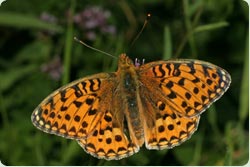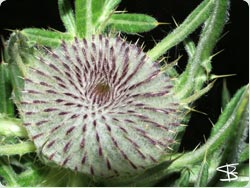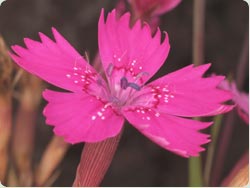Natural History of the Edge
Coombs Dale
A real gem of a limestone dale, Ash woodland guards its entrance, effectively deadening noise from the outside world.
In winter luxuriant carpets of moss cascade down the slopes; in spring colourful flowers such as Red Campion, Wood Forget-me-Not, Lesser Celandine and the elusive Moschatel make the most of the open canopy. Hawthorn, Hazel and Blackthorn line the track, providing food for the winter migrant Redwings and Fieldfares.
Dark Green Fritillary: One of the less common butterflies in the National Park, this species thrives on the Edge.
Halfway up the dale, the rock outcrops are well known for their ferns including Maidenhair Spleenwort, Wall Rue and Black Spleenwort, while the screes protect the rare Limestone Fern from hungry sheep. In summer, butterflies abound, visiting the sheets of flowers in the species rich turf. Less common species include the Northern Brown Argus, Dingy Skipper and the handsome Dark Green Fritillary.
Woolly Headed Thistle: Not many plants can look you directily in the eye but the Woolly Head certainly can. Growing up to 8 feet this is one of our rarest thistles.
Longstone Edge
Take a few minutes to enjoy the spectacular views of the White Peak to the south and the Dark Peak on the northern horizon.
Bee Orchid: Longstone Edge is renowned for its amazing array of orchids. The Bee Orchid is just one of a dozen species recorded within a couple of miles of the quarry.
The huge settling lagoons behind you on the climb out of Coombs Dale are associated with the fluorspar extraction at Cavendish Mill. Although unsightly, they host a large number of waterfowl visitors, including rare migrants from North America and continental Europe.
The steep grassy slopes and screes are an excellent habitat for masses of wild flowers, in particular drought-tolerant ones associated with such an exposed situation. Rock Rose, Thyme and Eyebright form multicoloured carpets in summer. Kestrel and Sparrow hawk haunt these slopes. Buzzards frequently circle overhead and, if you are lucky, the unmistakable croaks of Raven may be heard. Here rabbits abound and, if very quiet, you may catch sight of a Fox playing among the Gorse and Bracken.
Rowland
Rowland is a pleasant hamlet at the foot of the Edge surrounded by typical limestone plateau agricultural land. Much of the natural history interest here has been lost to ploughing and reseeding, although the field edges and walls are still a valuable refuge for some formerly more widespread plants and animals. The dew ponds nearby are often neglected now, but many still harbour newts including the rare and protected Greater Crested Newt.
Hassop
Two buildings dominate Hassop, both built by the Eyres, a prominent Catholic family. There is a fine late 17th century hall set in attractive parkland and surrounded by an impressive wall, now festooned with moss and Common Polypody Fem. The unusual church is built in the style of a classical temple. The hollow by the old school house marks the boundary between White and Dark Peak.
Backdale / Bramley Dale
Maiden Pink: A national rare and rapidly declining plant featured in the Red Data Book of highly vulnerable species. This fabulous rarity is in direct and imminent danger from the activities at Backdale.
In complete contrast to Longstone Edge, Bramley Dale’s northern ridge is composed of gritstone and supports a species-poor acidic grassland with patches of Bracken and plantations of Larch and Pine. These bustle with small birds looking for food; Blue, Great and Long Tailed Tits, together with Goldcrest, search the branches while Jays collect acorns from the Sessile Oaks.
Pheasants forage in the arable fields and Hares are frequently seen to the south of the ridge. Several families of introduced Grey squirrels inhabit the Beech and Chestnut plantation at the end of the ridge, and when it snows the tracks of Hares, Badgers, Foxes and Rabbits reveal the full extent of their nocturnal activity.





